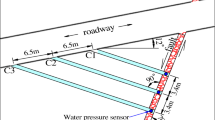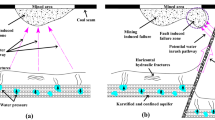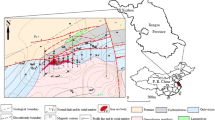Abstract
Water flow in faults made permeable by mining is potentially hazardous. We have found that (1) water flow due to this type of fault activation (FA) often occurs in the goaf near the working face (a zone of reduced stress); (2) the resistivity of the face goaf floor increases under normal conditions; and (3) electrical resistivity is obviously reduced during FA. At the Geting Coal Mine in China’s Shandong Province, the decrease in resistivity exceeded 40 Ωm when the fault began seeping. An experiment conducted at Face 2313 of the Geting Coal Mine showed that it is feasible to use electrical measurements to monitor and predict FA. Based on these conclusions, we established a monitoring criterion for FA.
Zusammenfassung
Wassereinbrüche auf Störungen, die durch den Bergbau durchlässig wurden, sind potentiell gefährlich. Wir haben herausgefunden, dass (1) Wassereinbrüche durch die Störungsreaktivierung oftmals im Alten Mann nahe des Abbauorts auftreten (Auflockerungszone), (2) der elektrische Widerstand an der Sohle des Abbauortes unter normalen Bedingungen ansteigt, und (3) der elektrische Widerstand offensichtlich durch die Störungsreaktivierung erniedrigt wird. Im Kohlenbergwerk Geting in der chinesischen Provinz Shandong sank der elektrische Widerstand um mehr als 40 Ωm, wenn Wasser aus der Störung zu sickern begann. Ein Experiment am Abbauort 2313 im Kohlebergwerk Geting zeigt, dass die Eigenpotentialüberwachung zur Kontrolle und Prognose der Störungsreaktivierung anwendbar ist. Anhand dieser Ergebnisse haben wir Überwachungskriterien für reaktivierte Störungen formuliert.
Resumen
El flujo de agua en fallas convertidas en permeables por la minería, es potencialmente peligroso. Hemos encontrado que (1) el flujo de agua debido a este tipo de activación por falla (FA) frecuentemente ocurre en las escombreras cerca del frente de trabajo (una zona de stress reducido); (2) la resistividad del piso de la escombrera se incrementa bajo condiciones normales; y (3) la resistividad eléctrica es obviamente reducida durante FA. En la mina de carbón Geting en la provincia de Shandong en China, el descenso en resistividad excedió 40 Ωm cuando la falla comenzó a filtrar. Un experimento realizado en la cara 2313 de la mina de carbón Getting, mostró que era factible usar medidas eléctricas para monitorear y predecir FA. Basados en estas conclusiones, hemos establecido un criterio de monitoreo de FA.
摘要
在采动条件下,断层活化是煤矿突水的重要原因。研究发现:(1) 断层活化、导水主要发生在工作面采空区(应力降低区);(2) 在一般情况下,工作面采空区(应力降低区)电阻率升高;(3) 断层发生活化、导水时,断层电阻率明显降低。当山东省葛亭煤矿F6断层的电阻率降至40 Ωm以下时,断层开始渗水。葛亭煤矿2313工作面井下监测试验证明,通过断层电阻率监测来预测断层活化是可行的,文章建立了断层活化的监测标准。
Similar content being viewed by others
Explore related subjects
Discover the latest articles, news and stories from top researchers in related subjects.Avoid common mistakes on your manuscript.
Introduction
Many floor water inrushes are directly related to faults that have been activated by mining. In this case, fault activation (FA) refers to a fault that did not conduct water until it was disturbed by mining, which caused it to become a water-conducting passage. FA is highly unpredictable and prone to cause disasters; hence, it is a great menace to underground projects (Hu 2005; Zhao 2007). Common water-conducting faults are often reinforced during coal mining by injecting concrete slurry or setting up water-resistant coal pillars in advance. However, it is difficult to prevent water inrush events caused by FA. Therefore, it is necessary to study the mechanism of FA to predict and prevent it.
At present, early warning of mine water inrushes involves monitoring (e.g. monitoring of water levels in adjacent strata, electrical monitoring, angular displacement monitoring; Liu 2008; Xu and Sui 2009; Zhang 2000; Zheng 2004), among which, electrical monitoring is the most mature. In this article, we derive a principle of resistivity distribution during face mining and a method of electrical monitoring based on resistivity distribution during FA.
FA Temporo-spatial Evolution
During mining, the stress exerted on the coal seam floor and the resultant displacement of the floor are in dynamic equilibrium, generally rising and falling periodically. Mining causes the load on the coal seam roof to be transferred onto the coal body (or waste rock) in the front or rear of the working face, where it forms a peak area of bearing pressure. The corresponding region on the floor also bears high stress, which can eventually destroy floor integrity. On the other hand, the rock body of the goaf area is depressurized, forming a tensile stress zone over a certain depth, which can also contribute to the destruction of the mine floor. Because the working face is continually being advanced, the mine floor is periodically compressed, extended, recompressed, and re-expanded. The distribution of stress loaded on to the floor of working face is shown in Fig. 1.
If there is only one fault zone in one working face, the fault zone might be destroyed by compression or shearing when stress is applied to the fault as the face advances. According to Shi and Han (2004), when the shear force is parallel to the fault zone, and the shear force is larger than or equal to the shear strength of the fault surface τn, the fault is subject to a dislocation-caused fracture and failure of the coal and rock in the fault zone, which make seepage possible. As the face advances, the stress loaded on the fault decreases and if the hydrostatic pressure of the groundwater in the zone of progressive intrusion near the fault is greater than the normal stress of the fault surface, cracks in the destroyed fault zone will enlarge and the permeability through them will rapidly increase, causing water percolation. Thus, FA occurs in the de-stressed region in which the fault advances. In other words, FA occurs in the goaf. This is in accordance with Gao (1999), who showed that 98 % of water bursts through faults occurred in normal faults, of which 85 % occurred while the upper part of these faults happened to intersect the goaf. Over time, FA lags behind the advancing working face, causing the FA to occur in the goaf.
Changes in Resistivity of Working Face Floor in Mining
The stress on the face floor changes during mining, as shown in Fig. 1. Therefore, we hypothesized that the apparent resistivity of the face floor would change correspondingly. To test the hypothesis, we observed various coal mines. Changes in the resistivity of the floor near the face were detected at Face 9115, Bucun, Zibo Mining Group, China (Fig. 2), and at Face 8403, Mine 5, Yangmei Group, China (Fig. 3). These figures show that increased electrical resistivity of the goaf (i.e., the reduced stress zone) corresponds to a decrease in the resistivity of the leading stress zone in front of the working face. To further analyze this issue, we measured the resistivity of the face floor at different depths at the Bucun Coal Mine. The relationship of resistivity to the depth of the face floor is shown in Fig. 4, where 0 m indicates the initial mining location. It can be seen that the resistivity of the goaf area (the reduced stress zone) is obviously higher than that in front of the coal wall of the working face. It is also clear that the resistivity of the face floor in the goaf (the reduced stress zone) generally increases, while the resistivity of the face’s coal wall (the advanced stress zone) generally decreases.
Resistivity in the Process of Fault Activation
In order to study the variation in resistivity during fault activation, we carried out experiments on the exposed normal Fault F 6, which is located in the rail-yard in the middle of the 230 West Wing downhill railway, in the Geting Coal Mine, Shandong Province, China. Fault F6 was verified to be a continuously permeable fault. In the experiment, we re-injected water into the fault, and monitored the changes in pressure with flow and the variation in resistivity.
The whole observational system in the experiment included three measurement lines arranged in two observational holes and one roadway. The observational line in the roadway was perpendicular to the two observational holes, forming a 3-D observational system. Each observational line was equipped with an electrical probe connected through the data transmission lines to the data collection station, as shown in Fig. 5.
The experiment proceeded in three stages. First, background data were acquired. Second, water was injected three times on Jan. 17, 2010, from 17:00 to 18:30, 20:25 to 21:25, and 21:40 to 22:10. The total influx was 1.9, 1.9, and 2.5 m³, respectively. The data were acquired synchronously with water injection on the three observational lines with electrical probes every 3 min. Fourteen hours after the experiment, data were acquired for 30 min. A total of 110 groups of data were obtained. The obtained data clearly show changes in resistivity near fault F6 during water injection. Data monitored from the observational line of the roadway are provided below. To better demonstrate the changes in resistivity that occurred during water injection, the resistivity values were reduced by the background values (i.e. the data measured the day before water injection). As shown in Fig. 6, after water injection, due to water influx, the local resistivity began to decrease. With water influx increasing, the coal rock region, which was lower than the injection points and had a lower resistivity, began to expand (Fig. 7). The more water that was injected, the larger the lowered resistivity region (Fig. 8); after the injection, the resistivity values gradually returned to their original values.
To further analyze changes in resistivity during water injection, we simulated the relationship of resistivity to time at a concrete position of the working face by using data acquired at different positions. Figure 9 shows one example of such changes in resistivity at the point beneath the water injecting point. It can be seen that the original value of resistivity at the point was 110 Ωm. During the first stage, resistivity decreased from 110 Ωm to about 80 Ωm; during the second stage, the value fell continuously to 60 Ωm, up to 40 Ωm less than the original value. The influx and pressure of water injection suddenly changed at this same time, indicating that the fault had been activated and steady water flow began. During the third stage, resistivity kept dropping until 22:34 (that is, 24 min after water injection), when the resistivity began increasing up to 100 Ωm at 22:46, then decreased a little, at last remaining above 100 Ωm. Changes in resistivity fully corresponded to water flow in the fault.
This experiment indicated that changes in resistivity in the coal rock layer are closely related to underground seepage percolation. Under normal conditions, changes in resistivity do not exceed 20 Ωm, but when FA allows water flow, the decrease in resistivity might exceed 40 Ωm. This resistivity change is positively correlated to the influx of water. However, the maximum decrement of resistivity does not exceed 100 Ωm.
Monitoring for FA
In the process of face mining, there are many factors that can change electrical resistivity. For example, variations in stress applied to the face floor can cause changes in resistivity although it is not related to underground seepage. Therefore, whether the fault is activated should be determined based on the temporo-spatial characteristics of fault activation rather than simply by changes in resistivity.
We concluded from the above study that: (1) FA often occurs in the goaf of working face (the reduced stress zone); (2) the resistivity of the goaf increases during normal conditions; (3) the resistivity obviously decreases with advancing FA. Thus, decreasing resistivity of the goaf can be used to indicate that FA is occurring. At the Geting Coal Mine, when the resistivity of working face floor in the reduced stress zone decreased by up to 40 Ωm, the coal seam began seeping, due to water flow in the fault. When the reduced resistivity region is larger and corresponds with the positions of the fault and Ordovician limestone water, FA has reached the Ordovician limestone aquifer. This means that it is necessary to take safety measures and withdraw all personnel from the area.
Monitoring Experiments on FA
The outside and downward Face 2312 of Geting Coal Mine was located on the upper part of Fault F6, which had the potential to transmit water due to its activation. In order to safely extract the face, we established a monitoring system of Fault F6, which mainly consisted of two monitoring lines (Fig. 10). One monitoring line was placed on the belt conveyor laneway of Face 2313, and the other was placed on the floor of the track laneway. A total of 64 electrodes were set up along each line and buried under the floor. The real time data acquired from these electrodes were transmitted through connected data wires to the general acquisition station.
We measured changes in resistivity of the face floor during mining in a real-time manner. Data were acquired continually for 32 working day, providing a total of 258,048 valid data points. Despite air return way or intake air way measured in the reduced stress zone of the goaf floor, the decrease in resistivity in most of the area did not exceed 40 Ωm, which meant that FA did not occur in the face floor.
Conclusions
By analyzing the correlation between groundwater pressure and stress during FA, and experimental data collected while injecting water into a permeable fault, we concluded that: (1) FA often occurs in the goaf, which is a reduced stress zone; (2) the resistivity of the goaf floor normally increases; and (3) resistivity is obviously reduced during FA. At the Geting Coal Mine, the decrement in resistivity exceeded 40 Ωm when the fault began seeping, so this was established as a safety criterion for FA. The FA experiment at Face 2313 Fault F6 indicated that using this criterion is feasible and that monitoring and predicting FA-induced water flow is possible.
References
Gao Y (1999) Rule of water burst and advantage face of water inrush. China University of Mining and Technology Press, Xuzhou, pp 12–15 (Mandarin)
Hu W (2005) Mine water hazard control theory and method. China Coal Industry Publishing House, Beijing, pp 18–19 (Mandarin)
Liu S (2008) Experimental research on mine floor water hazard early warning based on response of geoelectric field in groundwater seepage. Chin J Rock Mech Eng 28(2):267–269 (Japanese)
Shi L, Han J (2004) Study on mechanism and prediction of floor water invasion. Chinese University of Mining and Technology Press, Xuzhou
Xu J, Sui W (2009) Study and application on utilizing angular displacement to monitor failure of coal seam floor[C]//Ge Shirong. Proceedings on 6th International Conference on Mining Science & Technology. Elsevier, Amsterdam
Zhang X (2000) The research and application of microseismic technology in mine fractured and caving zones monitoring. Jo Chin Coal Soc 25(4):334–338 (Japanese)
Zhao T (2007) Typical water disaster cases and prevention techniques. China University of Mining and Technology Press, Xuzhou
Zheng G (2004) Research on coal mine water inrush mechanism and its real time monitoring techniques, PhD Dissertation, Chang An University, Xi’an, China
Author information
Authors and Affiliations
Corresponding author
Rights and permissions
About this article
Cite this article
Xu, J., Liu, S., Wang, B. et al. Electrical Monitoring Criterion for Water Flow in Faults Activated by Mining. Mine Water Environ 31, 172–178 (2012). https://doi.org/10.1007/s10230-012-0184-6
Received:
Accepted:
Published:
Issue Date:
DOI: https://doi.org/10.1007/s10230-012-0184-6














